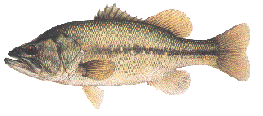The species known as Black Bass include two of the most sought after sporting fish in North America….The Smallmouth and the Largemouth Bass.
The Largemouth got its name because its upper jaw extends to behind its eye. Its coloring ranges from a dark or black back to green or olive-colored sides to a light belly. It has an uneven line of dark spots or bars that extend along its flanks to its tail. The spiny first dorsal fin is highest midway along its length and almost separated (forming a notch) from its soft second dorsal.
Largemouth Bass range from Minnesota to Quebec and south to the Gulf of Mexico. Originally a species of the southeastern US, it has been widely introduced elsewhere.
The northern largemouth seldom exceeds 10 pounds but the southern largemouth can exceed 20 pounds in weight. The IGFA all tackle record is 22 pounds 4 ounces caught in Georgia. Florida’s certified state record is 17.27 pounds.
Black Bass are the most sought after freshwater fish because of their wide range and their aggressive bone jarring strikes and the strength they exhibit during the fight. Being active predators they feed on a large variety of creatures and can be tempted to strike at practically any kind of bait or lure, either natural or artificial. Artificials could include plastic worms and grubs, spoons, spinners, crank baits and plugs. For bait fishing you could use worms, crayfish, leeches or minnows. The fly fisherman could use a variety of artificials such as bugs, streamers, poppers and bucktails.
Tackle for fishing with lures could include a 5-1/2’ to 7 ‘ spinning or baitcasting rod and reel with 6 to 12 pound monofilament. Fly fishing tackle could include a 7’ to 9’ bass fly rod with fast taper fitted with a fly reel fitted with a #7 to #9 floating line and a 6 to 8 pound leader.
The plastic worm is the most dependable artificial bait for largemouth bass. A weedless "Texas- or Carolina-rigged" worm is effective for fishing Florida lakes with heavy plant cover. Worms come in a variety of colors and scents, and bass may favor certain types depending on light conditions; be sure to have both light and dark colors available, as well as several sizes of tapered worm weights from 1/8 to ounce. Purple "metalflake" or "red shad" worms with twirly-tails are popular, and plastic lizards can be effective as well.
Most plastic worms are worked slowly along the bottom or through cover by raising the rod tip a few feet, then allowing the worm to sink. The line should be kept fairly tight to feel the strike. Typically an angler will feel the bass "tap" the worm once or twice lightly. By lowering the rod tip and waiting only until the slack is out of the line before setting the hook, anglers greatly lessen the chance of injury to the fish due to deep hooking.
With active bass and dense underwater vegetation, "jerk worms" are an excellent bait. Rigged without sinkers, these worms are jigged rapidly over vegetation, with brief pauses to let the worm sink slowly. Bass hit these baits hard, and an instant hookset is recommended.
 Spinnerbaits are very good in the spring, usually fished slowly around drop-offs and cover. If a slow retrieve fails, try "buzzing", i.e., retrieving the spinnerbait rapidly so the blades ripple the surface.
Spinnerbaits are very good in the spring, usually fished slowly around drop-offs and cover. If a slow retrieve fails, try "buzzing", i.e., retrieving the spinnerbait rapidly so the blades ripple the surface.
Crankbaits typically imitate baitfish or crayfish, and a straight retrieve is usually effective. The design of the plastic lip determines how deep the lure dives, and anglers can adjust their choice of baits based on water depth. Popular colors are white, shad, firetiger (green striped with orange underside) and crayfish.
Topwater baits are exciting to fish because the angler can see the strike. Topwater plugs that imitate wounded baitfish may be twitched to entice bass. Others are designed to make noise, and a faster, erratic retrieve may antagonize a bass into striking. Topwater lures are most successful during early morning or late afternoon. Stay ready for a surprise strike and set the hook immediately.
Although the largemouth bass is by far our most common black bass, other species are found in Florida. The smaller Suwannee bass occurs in the Suwannee River and its tributaries, and in the Ochlockonee River. Favoring rock outcrops and moving water, Suwannee bass prefer crayfish to many prey items of largemouth. Crayfish-imitating crankbaits worked through deep-water bends will attract these hard fighting fish, as will plastic worms, plastic lizards or crayfish. The Santa Fe River is another good spot, and trophy-sized Suwannee bass up to three pounds can be found in the Ochlockonee River north of I-10.


0 Comments:
Post a Comment
<< Home